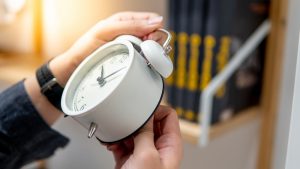Daylight Saving Time is here again, accompanied by increased pressure from many lawmakers to make the time change a permanent one, abandoning Standard Time for the most part. However, many scientists urge caution when considering such a change. That is because there are numerous studies demonstrating the ways that Daylight Saving Time hurts your health.
While many scientists and health experts do support ending the twice-yearly time change, they agree that permanent Standard Time would be the better choice in the context of overall health and well-being.
How Daylight Saving Time Hurts Your Health
 Most people have probably experienced the most immediately obvious impact of the shift into Daylight Saving Time – insufficient or disrupted sleep. Even a single night of insufficient or disrupted sleep can impact your cognitive function and mood. A few nights of insufficient sleep, according to a University of South Florida study published in the Annals of Behavioral Medicine, can yield physical symptoms, including gastrointestinal issues, sore muscles and decreased immune system protection, as well as mental health and function related symptoms. That’s interesting, especially in light of the fact that it can take up to a week to, in terms of sleep, fully adjust to the shift to Daylight Saving Time.
Most people have probably experienced the most immediately obvious impact of the shift into Daylight Saving Time – insufficient or disrupted sleep. Even a single night of insufficient or disrupted sleep can impact your cognitive function and mood. A few nights of insufficient sleep, according to a University of South Florida study published in the Annals of Behavioral Medicine, can yield physical symptoms, including gastrointestinal issues, sore muscles and decreased immune system protection, as well as mental health and function related symptoms. That’s interesting, especially in light of the fact that it can take up to a week to, in terms of sleep, fully adjust to the shift to Daylight Saving Time.
Researchers have long noted the increase in traffic accidents, workplace injuries and heart attacks that occur in the few days following the Daylight Saving Time clock change. A recent study found a 24 percent increase in heart attacks on the Monday after the spring clock change. That changing of the clock disrupts the sleep-wake pattern you’ve become accustomed to since the last clock change, also disrupting your circadian rhythm.
The circadian rhythm, an approximately 24-hour cycle in tune with the rhythm of day and night, helps to regulate the timing of a broad range of bodily processes, including hormone production and release. Insulin, for example, is a hormone essential to the metabolic system, melatonin is a key hormone involved in sleep timing and cortisol is a hormone that helps us to feel alert after waking.
Sleep — both duration and quality — and circadian rhythm health are an intrinsic part of optimal physical health, cognitive functioning and mental well-being. Chronic sleep and circadian rhythm disruption are associated with an increased risk for a wide range of diseases and chronic health conditions, including obesity, type two diabetes, cardiovascular diseases and some types of cancer. This twice-annual time disruption is detrimental to short-term and long-term health, contributing to the disordered sleeping and disrupted biorhythms that can lead to increased disease risk.
Permanent Standard Time a Better Choice
While currently there is active legislation in certain countries seeking to replace the twice-yearly time change with permanent Daylight Saving Time, many experts say that Standard Time would be a better choice because it is more in line with how our bodies evolved to work. After all, our current period of artificial lighting and modern living is just a brief blip in the span of our history. For the vast majority of our species history, we’ve been active during the day and slept at night. Perhaps that is why many maintenance tasks, such as the flushing of toxins from the brain and the strengthening of immune system memory, take place during deep sleep.
Light is the most powerful environmental cue for the circadian rhythm. With Daylight Saving Time, an hour of morning daylight is shifted via the changing of the clocks to evening. That can disrupt the timing of cortisol production and release in the morning and is also disruptive to the production and release timing of melatonin in the evening. That can cause problems with the sleep-wake cycle as well as impact circadian rhythm health. Standard Time offers a better alignment between our natural rhythms and the sun.
Because of that, Standard Time does seem to be better for our health. Indeed, the same study that found a 24 percent increase in heart attacks on the Monday after the Daylight Saving Time change also found a 21 percent reduction in the heart attack rate on the first Tuesday after the clocks returned to Standard Time in the autumn. It does seem to be easier for people to adjust to the Standard Time clock change as compared to adjusting to the start of Daylight Saving Time, according to a German study that included 55,000 people.
Ease Into the Change

Don’t use electronics, including mobile phones, tablets and computers, in the two hours before bedtime. Take extra care with the timing of caffeinated beverages during the time transitioning period. If you struggle more than most with the time change, you may want to consider using a correctly timed melatonin supplement during the clock change transition period.







